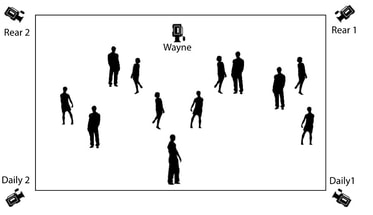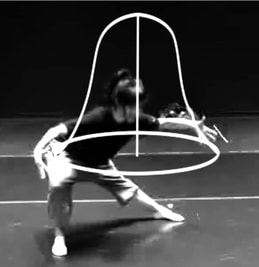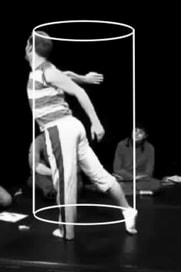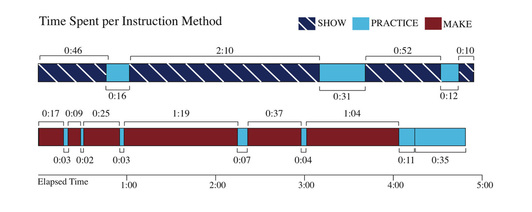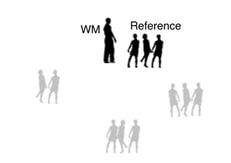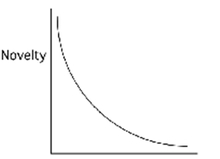UDC:793.32.038.53(410)"20"
793.32.07:929 Макгрегор В.
COBISS.SR-ID 221741068
Received:02.July.2015/
Accepted:15.Sept.2015
#1
Choreographic Methods for Creating Novel, High Quality Dance
David Kirsh
Dept of Cognitive Science, UCSD, La Jolla CA 92037;
e-mail: [email protected]
Dafne Muntanyola-Saura
Centre d'Estudis Sociològics sobre la Vida Quotidiana i el Treball (QUIT),
Institut d'Estudis del Treball (IET), Universitat Autònoma de Barcelona;
e-mail: [email protected]
R. Joanne Jao
San Diego State University
e-mail: [email protected]
Amy Lew
Adobe Systems, Inc. 601 Townsend St. San Francisco, CA 94107;
e-mail: [email protected]
Matt Sugihara
San Francisco, CA 94110
e-mail: [email protected]
Dept of Cognitive Science, UCSD, La Jolla CA 92037;
e-mail: [email protected]
Dafne Muntanyola-Saura
Centre d'Estudis Sociològics sobre la Vida Quotidiana i el Treball (QUIT),
Institut d'Estudis del Treball (IET), Universitat Autònoma de Barcelona;
e-mail: [email protected]
R. Joanne Jao
San Diego State University
e-mail: [email protected]
Amy Lew
Adobe Systems, Inc. 601 Townsend St. San Francisco, CA 94107;
e-mail: [email protected]
Matt Sugihara
San Francisco, CA 94110
e-mail: [email protected]
|
Acknowledgments: The Fulbright Comission funded Dafne Muntanyola-Saura in 2009-2010 while working on this paper. The authors thank the students of Cognitive Science classes 160/260W and 160/260S in 2009 for countless hours coding and organizing our hundreds of hours of video. We also thank Scott de Lahunta and Phil Barnard for insightful conversations; and of course, the generous time and kindness of Wayne McGregor and all the dancers in Random Dance.
Citation: Kirsh David, Dafne Muntanyola-Saura, R. Joanne Jao, Amy Lew, Matt Sugihara. 2016. "Choreographic Methods for Creating Novel, High Quality Dance." Accelerando: Belgrade Journal of Music and Dance 1:1
|
ABSTRACT
We undertook a detailed ethnographic study of the dance creation process of a noted choreographer and his distinguished troupe. All choreographer dancer interactions were videoed, the choreographer and dancers were interviewed extensively each day, as well as other observations and tests performed. The choreographer used three main methods to produce high quality and novel content: showing, making-on, and tasking. We present, analyze and evaluate these methods, and show how these approaches allow the choreographer to increase the creative output of the dancers and him. His methods, although designed for dance, apply more generally to other creative endeavors, especially where brainstorming is involved, and where the creative process is distributed over many individuals. His approach is also a case study in multi-modal direction, owing to the range of mechanisms he uses to communicate and direct. Keywords: choreography, multi-modal instruction, dance |
Introduction
Here we discuss our developing understanding of the methods used by a world famous choreographer, Wayne McGregor, when he works with his dance troupe, Random Dance, to create highly original dance pieces. (The choreographer, Wayne McGregor is the choreographer in residence for the Royal Ballet at the Royal Opera House in Convent Garden, London. His own troupe, Random Dance, is the resident dance troupe in Sadler’s Wells theater. McGregor came to UCSD in 2009 as an artist in residence to collaborate with David Kirsh in a cognitive study of the dance creation process.) These methods are of particular interest because, in McGregor’s hands, they have been remarkably successful at generating novel, high quality dance creations. They are also of interest because of what they teach us about distributed creativity more generally, and non-verbal interaction using multi-sensory imagery. Dance is a very physical medium, both in performance and the way it is created. When creating dance, choreographers often engage their dancers in a bodily way (Gallagher 2005). This is not unique to dance but in other domains, it is less evident and hard to study. We are finding that through careful observation and analysis we are acquiring new insights into creativity, and multi-modal communication. Our discussion has four parts: Methodology, Findings, Analysis, and Discussion.
Methodology
Our goal in this study was to exhaustively collect data of the creative process in dance, to create a complete archive of that process, and to analyze the methods, outcomes and distributed cognition of Wayne McGregor and Random Dance. The dance team worked for thirteen days on a new dance piece at UCSD, the spring of 2009. Their time at UCSD represents about 60% of the total time allocated to creating the final work. Neither the music nor the sets, both specially commissioned by Wayne McGregor, had yet been made. So our first surprise was that music is not used in the early phase of creation as a mechanism for generating dance phrases. Whenever the dancers worked, there was music present. But they danced with the music, not to it. We will not discuss music further.
The data we captured and used in our analyses fall into seven categories. Jointly they comprise a thorough documentation of the entire distributed creative process: 1. Video: The two dance venues used by the company were instrumented with five high definition video cameras on the walls and two standard camcorders on the ceiling (See Fig 1). These cameras were run an average of six hours a day for thirteen days, covering the times when the choreographer was present and whenever the dancers were practicing movements. 2. Field notes: Teams of students sat on the sidelines during the entire process and took notes on movements, interactions, and instructions each day. For each dancer there was a dedicated team of 2-3 students, eleven teams in all. Their field notes helped us to organize and annotate the video archive. 3. Choreographer interviews: The choreographer was interviewed before and after each working day – a total of 22 times in all – often for an hour at a time. 4. Dance interviews: Four dancers were interviewed two at a time, each day. When appropriate, the dancers ‘danced’ their answers to our specific questions about the day’s activities. This was especially helpful when the day’s activities required the dancers to visualize, or use other sensory imagery, to help create movement ideas. These interviews were also videoed (Banks, 2005). 5. Motion capture: Three dancers, each performing several dance phrases, were captured using a sixteen-camera VICON system. This produced 3-D trajectories of the dancers in motion. 6. Psychological tests: Each dancer performed a memory test for dance phases and identified key positions or ‘movement anchors’. These anchors are used to help recall attributes and positions and offer insights into memory. 7. Diaries and notebooks: Photographs were taken of all written artifacts used by the dancers and choreographer. These notebooks and diaries are used to help solve problems, recorded ideas, and remember movements and phrases. |
|
To organize and code this data two classes were created at UCSD to provide the trained labor needed. A master vocabulary of keywords was established and used to produce a single master list of activities, time coded to facilitate video indexing following ethnographic methods (Williams 2006). This served as a guide to what we might find at different moments in the video. The next step was to annotate snippets of video showing activities of particular interest. Students were allowed to choose particular dance phrases from amongst the 14 phrases the troupe performed in the final review on the last two days. They then tracked the activities that led to the evolution of those phrases over the course of the thirteen days, creating snippets that could be compared on a split screen or spliced together to make a video of the morphogenesis of a phrase.
Interviews were a further source of insight into the creative process. Each day, Wayne McGregor was asked to explain his goals for the day and describe what actually transpired. The interview was open ended and after the first ten minutes, the conversation turned to basic questions concerning choreographic choice, objectives, values, tasks, imagery, etc. Of the 60 hours of interviews collected from Wayne McGregor and the dancers, 35 hours were transcribed, and the process of keywording and indexing begun. Much of Wayne McGregor’s speech during the day was also transcribed from cameras and microphones. |
Findings
|
| Vehicles Carryng Information | Information Carried |
|---|---|
| Words and Syntax | Forms, moods, general tempo, how a role is to be placed |
| Prosody or information | Nuance about shape, tempo, mood |
| Gesture | Forms, modification of form, dyniamics of form |
| Touch | Correction of form, prodding to incite movement, pivot point |
| Vocalization | Some structural aspect of form, dynamics of form |
| Full body display (dancing) | Imitate this form, thougth in an idealized manner |
| Position on stage | Position or orientation on stage |
|
Sound for communicating rhythm is almost universal: ”One, two, three; one, two, three … ”. But sound to communicate form, feeling, or ‘quality’ is less familiar. Wayne McGregor regularly offered corrections, or communicated some aspect of dynamic form by calling out phrases such as “N’yahh uh oom” or “Tri dah day”. We call this use of sound ‘vocalization’. The goal of vocalization was clearly to direct and alter dancer movement. But in subsequent studies, we were not able to prove that all dancers interpret the sound the same way. This may be because its function varied between dancers. To some, it communicated a dynamic or gestural form; to others, it communicated a feeling; and to still others, it helped them to remember the dynamics of a phrase they already had mastered. Moreover, because dancer and choreographer were invariably in close proximity when vocalizing, the use of vocalization often led to further interaction. It is usually a move in a sequence of multi-modal interactions.
We also observed emergent communicative meaning arising because multiple modalities, such as words and gestures, gestures and vocalization, were used at once. In table 2, we display a five-minute period of instruction and the duration of different modalities in use. Note how many of the channels overlap. In particular, in the early phase of this instruction – around the first minute – we see that Wayne McGregor combines words with gestures, dancing, touch, and positioning. |
|
Methods of Instruction. We now describe three methods of instruction we found Wayne McGregor using and provide a framework from which to conceptualize their differences.
1. Show a phrase to the whole troupe or large subset. Wayne McGregor uses his own body to display the structure and dynamics of a move or phrase (See Picture 1). He has two styles. He either dances amidst the troupe in the same physical orientation as everyone else; or he faces the group, as if teaching. He expects the entire troupe to observe and reproduce the move, though, for some moves, the dancers are expected to execute in a ‘more perfect’ manner. |
|
2. Make a phrase on a target dancer (solo), or a duo, a trio or quartet. This method of direction involves using the bodies of specific dancers as targets on which to shape the form and dynamics of a move or phrase. Typically, the entire troupe watches these target dancers and later will reproduce those movements in their own duos, trios, or quartets. There are also occasions, however, where the point of a ‘make on’ is solely for the target dancers (see Picture 2). A further form of ‘making a phrase on’ occurs when Wayne McGregor adapts or modifies a phrase originally created by the dancers. In that case, making on is more like reshaping.
|
Picture 2. Wayne McGregor makes on a duo in 2a, and in 2b,
the troupe observes and copies. Wayne McGregor is taller and shaved. Notice how close choreographer and target are, and the density of interaction. |
|
Picture 3. As shown in the pictures, one dancer imagines moving a heavy bell around ; another dancer imagines interacting with a barrel – stepping into it, demarcating its boundaries and then moving outside it and pushing on it from the outside.
|
3. Task or pose a choreographic problem. In this third kind of direction, the choreographer assigns ‘choreographic problems’ for the dancers to solve or choreographic ‘tasks’ for the dancers to complete. Typically, these problems or tasks require the dancers to create some sort of mental imagery – a landscape of Manhattan, the feel of being touched on a certain part of their body, the dynamic and kinematic feel of being a piston moving back and forth. Often, the way the problem is posed requires the dancers to invent an image or scenario for themselves. The choreographic problem is to use this imagery in some way to create a virtual structure that they are then able to relate to in a ‘choreographically’ interesting manner (see Picture 3). Using this threefold classification of methods, we reviewed the video to determine how the methods were involved in the actual creation of phrases.
Evolution of Phrases. In table 3, we show the details concerning the evolution of each phrase. It is apparent that a phrase is never the outcome of a single instruction method or directive. Sometimes the choreographer will come to a session with a clear idea of a movement he wants the dancers to learn. In that case, he will either Show them all, or Make on a duo, trio, or quartet. More often, though, he will begin the creation of a new phrase by assigning a choreographic problem or task. As can be seen below, nine of the sixteen phrases started with a Task, five with a Make On, and two with a Show.
|
| # | Trajectory (munutes spent) |
Total Duration (minutes) |
Usable Material (m:ss) |
|||
|---|---|---|---|---|---|---|
| Task | Show | Make | Total | |||
| 1 | Make(26) | Make(36) | 0 | 0 | 62 | 62 | 1:07 |
| 2 | Show(42) | Task(3) | Make(28) | 3 | 42 | 28 | 73 | 2:46 |
| 3 | Show(54) | Task(11) | Make(33) | 11 | 54 | 33 | 98 | 0:34 |
| 4 | Task(51) | Task(6) | Task(54) | 111 | 0 | 0 | 111 | Not in Final Review |
| 5 | Task(63) | Show(31) | Task(18) | 81 | 31 | 0 | 112 | Solo: 37:00 Duet: 8:20 |
| 6 | Make(26) | Show(69) | Make(66) | 0 | 69 | 92 | 161 | 2:12 |
| 7 | Task(9) → Task(63) → Make(7) | Task(55) | 127 | 0 | 7 | 131 | 3:00 |
| 8 | Task(40) → Make(46) | Task(49) | Task(31) | Make(35) | 155 | 0 | 46 | 201 | 7:40 |
| 9 | Task(60) | Task(55) | Task(34) | Task(4) | 153 | 0 | 0 | 153 | 0:53 |
| 10 | Task(146) → Make(33) | Task(37) | Task(84) | Task(85) | 375 | 0 | 33 | 408 | Solo: 00:47 Duet: 10:50 |
| 11 | Make(68) | Task(34) | 34 | 0 | 68 | 102 | 15:05 |
| 12 | Make(69) | Task(87) | 87 | 0 | 69 | 156 | 1:55 |
| 13 | Task(67) | Task(58) → Make(124) | Make(37) | 125 | 0 | 161 | 286 | 5:00 |
| 14 | Task(110) | Task(113) | 223 | 0 | 0 | 223 | Not in Final Review |
| 15 | Task(102) → Make(93) | Make(41) → Task(13) | 115 | 0 | 134 | 249 | Solo: 1:05 Duet: 2:20 |
| 16 | Make(51) | Make(5) | 0 | 0 | 56 | 56 | 3:46 |
|
Analysis. Each of these methods has its individual strengths and weaknesses, both in terms of productivity, long run value, and creative potential.
Tasking. Based on the time spent using a method, the number of times it was used, and the number of usable minutes generated, the most important method is clearly Tasking / Problem solving. As seen in table 4 (below), 62% of instruction time – that is, time dancers were not practicing – was devoted to working on tasks. This 62% delivered 60% of the final output. Although tasking sessions were marginally longer, 55 mins. vs. 46 and 44 mins. for making and showing, Tasking was still the method of choice, being called on 58% of the time. In interview, the choreographer provided several additional reasons for valuing Tasking more highly than other methods. He mentioned that by assigning the dancers problems to solve they stretch their repertoire more effectively – they discover new ways of moving themselves; he, the choreographer, has the opportunity to see new things that the dancers can do, and therefore, he may use those dancers differently in the future or ‘make on’ them differently; he believed that if a movement originated as a solution to a problem, the dancers are likely to imbue it with greater feeling, affect or quality – what some call greater intentionality; they will find the phrase easier to remember; and they will have intellectual ‘anchors’ that can serve as reference points in the phrase later. |
| Instruction Type | Frequency | Mean Duration | Total Product | ||
|---|---|---|---|---|---|
| Times Used | % of total instruction time | Minutes | Minutes | % of total instruction time | |
| Task/Problem Solving | 29 | 62.00% | 55.17 | 63.07 | 60% |
| Make On | 17 | 30.50% | 46.41 | 25.52 | 25% |
| Show | 4 | 7.50% | 49 | 15.24 | 15% |
|
There are further reasons to view Tasking as of special interest, particularly for those interested in the nature of creativity. First, because dancers themselves must solve tasks, and because each dancer’s imagination is different, inevitably there will be as many solutions as dancers. These solutions can be vastly different. And even if the phrases a dancer makes falls short of acceptability, it still may engender ideas in Wayne McGregor. We regularly observed him trying out dancer ideas on himself, and then later putting these altered ideas to use in a Show or Make. We also regularly found Wayne McGregor using a dancer’s solution as a base that could be reworked or ‘massaged’ into a different form.
Second, tasks increase the resources available to dancers when looking for inspiration. Imaginary structures or feelings can serve as scaffolds for a dancer. The challenge any dancer faces is to make a sustained phrase: not just a nice move here or there, but something that lasts 40 seconds or a minute. It is no surprise, then, that people like dancing with other people. A person makes a nice foil for a partner to interact with. When a person is absent, a physical structure can serve a similar role, though any dynamism must come from the dancer. On an empty stage, structures are absent. At such moments imagination, when guided, can fill the void. This has the effect that dancers will often be dancing in relation to something that only they are aware of. A third virtue of tasks is that they breed diversity; the phrase one dancer comes up with may be stylistically different than the phrase another comes up with. |
| Prase# | Usable Material (minutes) |
Proportion of Time Spent on Each Method | Minutes of Material Generated by Each Method | ||||
|---|---|---|---|---|---|---|---|
| Task | Show | Make | Task | Show | Make | ||
| 1:44:23 | Total Lenght of Material Generated | 1:03:07 | 0:15:24 | 0:25:52 | |||
| 1 | 1:07 | -- | -- | 100% | -- | -- | 1:07 |
| 2 | 2:47 | 4% | 58% | 38% | 0:06 | 1:35 | 1:06 |
| 3 | 0:34 | 11% | 55% | 34% | 0:04 | 0:19 | 0:11 |
| 4 | * | n/a | n/a | n/a | n/a | n/a | n/a |
| 5 | 45:21 | 72% | 28% | -- | 32:47 | 12:34 | -- |
| 6 | 2:12 | -- | 43% | 57% | -- | 0:56 | 1:16 |
| 7 | 3:00 | 95% | -- | 5% | 2:50 | -- | 0:10 |
| 8 | 7:41 | 77% | -- | 23% | 5:55 | -- | 1:46 |
| 9 | 0:53 | 100% | -- | -- | 0:53 | -- | -- |
| 10 | 11:37 | 92% | -- | 8% | 10:41 | -- | 0:56 |
| 11 | 15:05 | 33% | -- | 67% | 5:01 | -- | 10:04 |
| 12 | 1:55 | 56% | -- | 44% | 1:04 | -- | 0:51 |
| 13 | 5:00 | 44% | -- | 56% | 2:11 | -- | 2:49 |
| 14 | ≠ | n/a | n/a | n/a | n/a | n/a | n/a |
| 15 | 3:25 | 46% | -- | 54% | 1:35 | -- | 1:50 |
| 16 | 3:46 | -- | -- | 100% | -- | -- | 3:46 |
|
Making. As can be seen from table 4, Making is responsible for 30.5% of Wayne McGregor’s time and 25% of the final product. Why is Makingmore prevalent than Showing?
The reason, we speculate, is that Making, like Tasking, is a technique that helps Wayne McGregor reach beyond himself. It is a mechanism for fostering novelty. In a 'make on', Wayne McGregor uses another dancer’s body in place of his own. The phrase that emerges invariably reflects something of the personal style of the dancer and something of the body style. In interviews, the dancers freely recognized that the way a phrase turns out, and the authority on how it should be performed always lies with the ‘makee’. Moreover, since making on involves a close coupling of choreographer and dancer the phrases that arise must be the product of a collaboration of sorts, even if the creative contributions are unequal. To explore this idea we counted the number and duration of turns that choreographer and dancer take while engaged in a 'make-on' vs. the number of turns taken during a 'show'. Our conjecture was that 'making on' is far more like a conversational dialogue than Showing, so we expected to find more back and forth activity. That is exactly what we did find. As shown in Figure 2 the number of momentary stops, pauses or opportunities for non-verbal dialogue that we observed in a randomly chosen ‘make’ far exceeds those we observed in a randomly chosen ‘show’. There were 32 turnovers in ten minutes of making vs. 14 in ten minutes of showing. This is to be expected given the differences between making and showing, since in making Wayne McGregor must be responsive to exactly what the target dancers are doing. When Wayne McGregor is making he is invariably close to the solo, duo or trio he is making on and so he will naturally work with them in a physical, tactile way. As they move so will he. Because of the physical nature of dancing, its speed and change in position, we would predict that the level and frequency of interaction would necessarily be high. |
|
In figure 2 we display dancer and choreographer mutual activity over five minutes of Showing vs. five minutes of Making. We analyzed ten minutes but display only five for greater visibility. The top activity line displays a showing episode; the bottom activity line is a making episode. When he Shows, Wayne McGregor, on average, communicates longer and the dancers practice longer. This is to be expected because they must copy him. But when he Makes he works in shorter bursts with the dancers. Overall, there are more exchanges, however. Accordingly, Making is more interactive than Showing.
|
|
Showing. Based on time and frequency, Showing is the least popular, but also, in some ways, it is the most potent. Every minute spentShowing yields 4.7 secs of usable product, compared to 2.4 secs of Tasking and 1.9 secs of Making. This makes sense since Wayne McGregor only Shows when he has material that he feels is likely to be usable. But unlike the other methods, Showing is the least collaborative method. The choreographer stands to learn little from the dancers. In table 6 we display the average number of seconds yielded by a minute of work in each of the different instructional methods.
|
Table 6. Yield (in secs) of a minute of method.
|
|
Group Attention, Group Intention. We began observing what dancers watched most; what they had in their center of attention. By center of attention, we mean the person whom the troupe observes, particularly while Wayne McGregor is instructing. Our prediction was that when Wayne McGregor is Showing, he is, himself, the center of attention; when Wayne McGregor is Making on a single dancer, or on a duo, the center of attention is Wayne McGregor and the 'makees' jointly if we ask about the rest of the dancers, and it is Wayne McGregor alone if we ask about the 'makees' (the targets); and when Wayne McGregor is Tasking, or when the dancers are themselves solving a choreographic problem, they are their own center of attention.
And, indeed, the center of attention (almost) behaves in this common sense way (see Goodwin 1994 for examples on professional vision). In cases where Wayne McGregor is ‘Making on’ a trio, the remainder of the troupe will listen to Wayne McGregor but watch the trio. Their attention is split, as we predicted. But they use the trio, and not Wayne McGregor, as the reference for the movement. They listen to Wayne McGregor but watch the target. The term reference is one we heard the dancers use to designate the authority, or role model, for the group when there is a question about the nature of a given movement. When a choreographer 'Makes on' a dancer, or a small group, it is reasonable to assume that the group evolving the movement, rather than the choreographer, is the center of attention and the way they perform the movement is the referent. We confirmed this through interview. Once a target 'makee' has mastered a phrase, and often even before, she/he or they are taken to be performing the movement in the definitive way. We observed many times that Wayne McGregor, too, will rely on 'makees' to recall the movement made on them, when he needs it again in the future. So far, this only weakly stretches our preconceived ideas. If the referent is the person who best knows a given phrase, it is natural to look to that person as the local authority. If a movement is being Shown, however, shouldn’t Wayne McGregor be the referent? He is the one who thought it up, he is the one who danced it to Show how it is to be executed, and he is the one we expect to remember it perfectly. Our biggest surprise was that this is not always true. The reason things sometimes deviate is that when Wayne McGregor is Showing, there is often another dancer who acts as a 'Surrogate Reference'. This is a dancer who can be counted on to precisely master the key aspects of the movement in near real time. Invariably, a surrogate reference will be someone who has worked with a choreographer a long time, or she/he will be someone with outlier skills in copying. A surrogate reference will be someone who reliably interprets what Wayne McGregor is trying to get the dancers to do, and can display that intent in a more accessible manner. The result is that there are cases where Wayne McGregor instructs by Showing, but many of the troupe, after initially watching Wayne McGregor, will actually watch the surrogate referent during subsequent re-showings by Wayne McGregor (See figure 3). In the instance we observed, this other dancer, A, is the longest standing member of the troupe. In interview with other dancers, it was reported that A has the best anticipation of what Wayne McGregor is trying to Show, and that, accordingly, it is often easier to copy A’s movements than Wayne McGregor’s. |
|
It is tempting to suppose that the movement performed by the reference dancer, or especially by the surrogate reference, is the very movement that all dancers should learn and memorize. Even this, however, is not always the case. At each moment, there is an intended movement – the Platonic ideal of that movement. But because of body idiosyncrasies, or because the ideal movement requires considerable practice, the Platonic movement each member of the troupe is aiming for may not yet have been displayed. The troupe may know what they are aiming for but no one has executed it yet. We call this ideal movement the intended reference movement.
The idea of a reference movement as an abstraction is supported by our observations about the surrogate reference. In some phrases, there are several surrogate references, each one specializing in particular aspects of the phrase: One dancer may be counted on to precisely note the grips or stance; another may be counted on to precisely note the emotional dynamics. The complete phrase must incorporate all of these elements. And to learn that phrase, different dancers may be called on by Wayne McGregor, during rehearsal, to show off the phrase. This distributed memory is part of what makes dance creation a worthy domain for the study of distributed creativity. |
Figure 3. In 3a, Wayne McGregor is showing a phrase and so is, himself, a reference for the dancers.But one of the dancers – a surrogate reference – knows Wayne McGregor’s intentions well and executes them in ways the others can follow easily. In 3b, Wayne McGregor makes on a trio and they serve as a reference for the onlooking dancers who must also learn the trio.
|
Discussion
We now turn to a more general discussion of the problematique of dance creation and what we have learned about the creative value of different instructional methods.
A major challenge in creating a new piece of choreography is that the work should ideally be both novel and of high quality (beautiful, interesting, absorbing). Achieving both attributes is especially difficult because of a trade-off: it is easier to be novel if one’s work need not meet existing norms of quality; it is easier to produce recognizably high quality work if one’s work need not be novel. Quality can be thought of as analogous to reliability in design. For instance, in classical ballet, where the movements have been refined over years, new works are essentially reliable forms combined in reliable ways. In figure 6 (below), we represent this trade-off on a 'iso-goodness' curve. It represents the 'goodness' of a choreographic product in terms of its novelty and quality. A very novel piece may be valued as highly as a high quality piece. And a piece of exceptional quality may be valued as highly as a piece of exceptional novelty. |
Figure 4. 4a shows the basic 'iso-goodness' curve. 4b shows that modern choreographers are biased toward novel work whereas classical ballet choreographers are biased toward quality. 4c illustrates that better choreographers live on a better 'iso-curve'.
|
Historically, modern dance has differed from classical dance in its norms for what is good. The best modern work should lie more toward the novel side, using few tried and true dance forms, and containing more inventive never-before-seen forms and moves. Accordingly, the best new creations in modern dance should lie somewhere near the upper left of the curve (see Figure 4b). Creations in classical ballet, by contrast, lie somewhere around the lower right. Despite these different biases or preferences, most work, with the exception of the best, tends to lie near the middle of the curve between novelty and classical quality (or beauty) because it is easier to create a piece in the middle region than at either extreme. Figure 4c illustrates that better choreographers live on a better 'iso-curve'. Their work never follows below a threshold of novelty and quality.
Great choreographers are noteworthy because they are able to push their 'iso-curve' outward (see Figure 4c). They can ensure that even their most novel, risky pieces meet a certain acceptable level of recognizable quality, and even their most safe pieces meet a certain acceptable level of novelty. How do they do this? How can they take risks and still be confident of coming through? The answer, we suggest, is that different choreographic methods have different risk reward profiles. Reliability in design is achieved through a wise distribution of methods, akin to an asset allocation. In Figure 5 (below), we show our view of the risk reward structure of Wayne McGregor’s methods of Showing, Making, Tasking. Showing is the most reliable use of time, but the least generative. Making is still a highly reliable use of time but leads to a larger set of novel moves. Tasking is the least reliable, in the sense that some tasks lead to no usable output. But it is also the most generative in providing novel movement. Choreographers with an eye to time and success will divide their time wisely among all three methods. |
Figure 5. 'Iso-curves' can be used to show where the methods of
Show, Make and Task lie on a risk-reward curve.
Show, Make and Task lie on a risk-reward curve.
Conclusion
Our parting conclusion:
The domain of choreography is a rich arena for research on the nature of distributed creative cognition, on multi-modal instruction, and phenomena of group attention, mental imagery and interactivity. We have just begun our inquiry into these areas and hope that others, too, will see the value of close observational and empirical study of artistic creativity. Note: The credits for the pictures go to UCSD research team, the ICL lab. |
Reference
|
This website is under Attribution-NonCommercial-NoDerivatives 4.0 International (CC BY-NC-ND 4.0)
Belgrade Center for Music and Dance is the publisher of Accelerando: BJMD
Belgrade Center for Music and Dance is the publisher of Accelerando: BJMD


